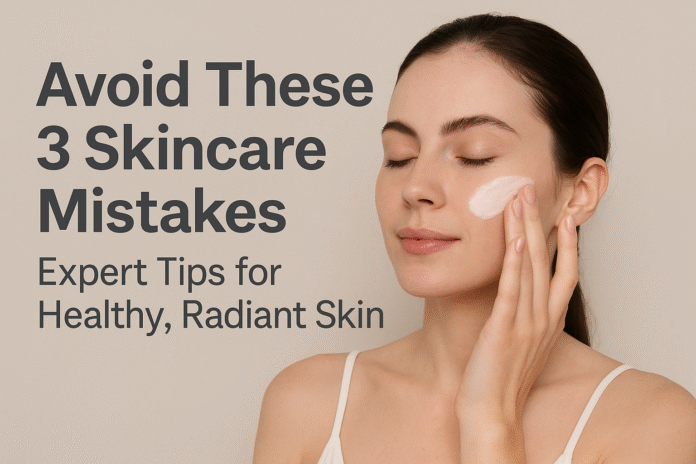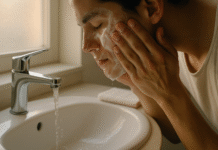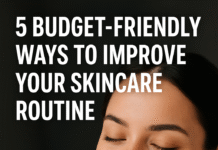If you want clearer, healthier, longer-lasting skin, start by avoiding the simple, repeatable mistakes most people make. In the first 100 words: this article covers the three most common skincare mistakes — skipping or misusing sunscreen, over-exfoliating / misusing active ingredients, and damaging the skin barrier through harsh cleansing and poor moisturizing — and shows exactly how to fix them. Whether you’re a skincare beginner, a busy professional, or someone tired of chasing quick fixes, you’ll get practical step-by-step plans, safety tips, a 4-week starter roadmap, troubleshooting, and clinical-backed guidance.
Disclaimer: This article provides general skin care information. For tailored medical advice about skin conditions, medications (including prescription retinoids), allergies or treatments, consult a qualified dermatologist or healthcare professional.
Key takeaways
- Sunscreen matters more than any single serum — daily broad-spectrum SPF + reapplication prevents sun damage and aging.
- Less is often more with actives. Over-exfoliation and mixing strong actives cause irritation and long-term barrier problems.
- Protect the skin barrier. Gentle cleansing, proper pH, and consistent moisturizing (humectant + emollient + occlusive) are the backbone of healthy skin.
- Patch test and introduce actives slowly (start low, “go slow”) to build tolerance and reduce risk.
- A simple, consistent routine beats fancy: cleanse, treat selectively, moisturize, and sunscreen.
Why these mistakes are so common (and why they matter)
Skin care is a crowded, noisy market. New ingredients, dramatic before-and-after photos, and “miracle” overnight results push people to layer on more products or jump into strong actives without preparation. Meanwhile, many people underestimate the daily damage caused by UV exposure or damage the skin barrier by stripping it with harsh cleansers and heavy-handed exfoliation.
The effects are not just cosmetic — a compromised skin barrier increases sensitivity, dryness, redness, and can worsen conditions like acne, rosacea, and eczema. Sun exposure drives most visible aging and increases the risk of skin cancers. That’s why fixing these three mistakes produces disproportionate, reliable improvements faster than chasing every trending serum.
Mistake 1 — Skipping or Misusing Sunscreen (and under-applying/forgetting to reapply)
What it is and why it matters
Sunscreen prevents both immediate sunburn and long-term UV damage (photoaging, pigmentation, and skin cancer). Many people either skip sunscreen on low-sun days, use too little, choose the wrong SPF, or fail to reapply — which drastically reduces protection.
Using the correct amount and reapplying regularly are essential. Daily broad-spectrum sunscreen (UVA + UVB) with at least SPF 30 is a widely recommended baseline, with higher SPF for prolonged outdoor exposure. Sunscreen should be reapplied at least every two hours and immediately after swimming, heavy sweating, or towel-drying.
Requirements / prerequisites (what you need)
- Product: Broad-spectrum sunscreen labeled SPF 30 or higher for everyday use; consider SPF 50+ for extended outdoor time.
- Extras: Lip balm with SPF, a mineral option if you’re sensitive to chemical filters, and travel-size bottle(s) for reapplication.
- Cost: Ranges from budget drugstore tubes to premium brands; effective choices exist at all price points.
- Low-cost alternatives: A tinted moisturizer or daily face product with SPF 30+ can work for everyday indoor/outdoor transitions — but treat it like sunscreen and reapply as directed.
Step-by-step: How to apply sunscreen correctly
- Final morning step: Apply sunscreen after your moisturizer and before makeup.
- Amount: Use roughly a nickel-sized dollop for the face and 1/4 to 1/2 teaspoon for face + neck; another practical technique is the “two finger” or “three finger” rule (a line of product along two fingers to cover face and neck).
- Cover the edges: Don’t forget ears, hairline, eyelids (use mineral or formula designed for eye area), and the back of the neck.
- Reapply every 2 hours when outdoors and immediately after swimming or heavy sweating. Indoor daytime exposure through windows still warrants daytime SPF application.
- Layering: If you use makeup with SPF, don’t rely on it as your only protection unless you apply the recommended amount and reapply. Use a dedicated sunscreen foundation or primer for better consistency.
Beginner modifications and progressions
- Beginner: Start with a facial mineral sunscreen or lightweight chemical sunscreen labeled non-comedogenic if you’re acne-prone. Use it every morning.
- Progression: For long outdoor days add a water-resistant high-SPF formula and combine with physical barriers (hat, sunglasses, UV-protective clothing).
- For sensitive skin: Try mineral (zinc oxide/titanium dioxide) formulas; they’re generally less irritating.
Recommended frequency/duration/metrics
- Daily application: Every morning as part of your routine.
- Reapplication: At least every 2 hours outdoors, and after water exposure or sweating.
- Metric of success: Fewer new sunburns, slower development of new pigmentation, less sunburning, and over time fewer fine lines and pigmentation changes attributable to sun damage. Track by photos every 3 months and note reductions in redness or sunburn incidence.
Safety, caveats, and common mistakes
- Mistake: Relying on incidental SPF from makeup or moisturizer without applying the required amount.
- Mistake: Believing a single morning application lasts all day.
- Caveat: If you have a known allergy to a sunscreen ingredient, patch test different formulas or try mineral options.
- Ingredient note: Some active prescription ingredients (e.g., retinoids, hydroxy acids) increase photosensitivity — apply sunscreen diligently when using them.
Mini sample plan (2–3 steps)
- Morning: Cleanse → lightweight moisturizer → SPF 30+ (face + neck + ears).
- Day: Reapply sunscreen every 2 hours when outside; carry travel-size spray or stick.
Mistake 2 — Over-exfoliating & misusing potent actives (acids, retinoids, vitamin C, benzoyl peroxide)
What it is and core benefits/purpose
Chemicals like AHA (glycolic/lactic), BHA (salicylic), retinoids (retinol, tretinoin), and physical scrubs are powerful tools when used correctly: they improve texture, unclog pores, fade discoloration, and stimulate renewal. But using too many actives, applying them too frequently, or combining incompatible ingredients causes chronic irritation, inflammation, and barrier breakdown.
Over-exfoliation is common: daily use of strong acids or scrubs, mixing acids with retinoids, or layering multiple active serums without ramping up tolerance. Over time, this can worsen dryness, increase sensitivity, and produce paradoxical breakouts.
Requirements / prerequisites
- Products: One treatment active at a time (e.g., either a mild AHA/BHA or a retinol), plus a soothing, hydrating moisturizer.
- Tools: pH-appropriate chemical exfoliants (leave-on serums or rinse-off masks), a gentle physical exfoliant if used rarely.
- Cost: Active treatments range widely; start with low-concentration, reputable formulas.
- Low-cost alternatives: Gentle AHA serums at low concentrations or low-strength retinols rather than prescription strength for beginners.
Step-by-step: How to introduce actives safely
- Patch test any new active (see practical patch test method below).
- Start slowly: For a new retinol, use once every 3–4 nights for two weeks, then gradually increase to every other night, then nightly as tolerated. For acids, begin with once per week and build up to 1–2 times per week.
- Avoid immediate mixing: Don’t use an AHA/BHA on the same night as retinol or other strong actives until tolerance is built. Introduce one product at a time for 4–6 weeks to evaluate reaction.
- Use supportive hydration: After treatments, wait recommended absorption periods, then apply a soothing moisturizer with humectants (glycerin, hyaluronic acid), emollients (ceramides, fatty acids), and occlusives (petrolatum, dimethicone) if needed.
- Sunscreen is non-negotiable: Acids and retinoids increase photosensitivity, so daily SPF is required.
Beginner modifications and progressions
- Beginner: Choose a low-strength retinol (0.01–0.03%) or mild AHA (5–8% lactic acid) and use once or twice weekly at night. Keep the rest of the routine simple and hydrating.
- Intermediate: Once tolerated, increase frequency to every other night for retinol or 1–2x/week for acids, and consider alternating nights (retinol one night, AHA nights 2x/week).
- Advanced: Under dermatologist guidance, higher potency prescription retinoids or combined regimens may be introduced; do so only if your barrier is robust and you’re under supervision.
Recommended frequency/duration/metrics
- Chemical exfoliants (AHA/BHA): 1–2 times per week for most skin types; sensitive skin less often.
- Retinoids: Start at 1–2 times per week, gradually increase to nightly over months as tolerated.
- Metric of success: Reduced congestion, smoother texture, fewer active irritation signs (redness, stinging). If persistent dryness, redness, or increased flaking occur, scale back.
Safety, caveats, and common mistakes to avoid
- Common mistake: Layering multiple strong actives in the same routine (e.g., retinol + benzoyl peroxide + strong acids).
- Caveat: Some people experience an initial “purge” when starting retinoids (transient increase in breakouts) — distinguish this from a true allergic or irritant reaction (severe burning, blistering, or spreading rash).
- Pregnancy/breastfeeding: Many retinoids should be avoided in pregnancy; check with your provider.
- Avoid mixing incompatible ingredients: For example, avoid pairing strong vitamin C acids and retinoids on the same night if it irritates you.
Mini sample plan (2–3 steps)
- Night (beginner retinol night): Cleanse gently → pea-sized low-strength retinol (every 3rd night) → hydrating moisturizer.
- AHA night (alternate): Cleanse → low-strength AHA (once weekly to start) → moisturizer → sunscreen next morning.
Mistake 3 — Damaging the skin barrier: harsh cleansing, wrong pH, and skipping moisturizers
What it is and core benefits/purpose
The skin barrier (stratum corneum + acid mantle) keeps moisture in and irritants/pathogens out. Harsh surfactants, high-pH cleansers, frequent rubbing, hot water, or stripping oils remove lipids and natural moisturizing factors. The result: tightness, flaking, increased transepidermal water loss (TEWL), redness, inflammation, and sensitivity.
A balanced cleansing routine preserves the barrier while removing dirt, sebum, and pollutants; moisturizing helps repair and reinforce the barrier. Scientific reviews show cleansers with neutral/acidic pH are less likely to disrupt the barrier than high-pH cleansers. Moisturizers reduce TEWL and replenish lipids, improving barrier function.
Requirements / prerequisites
- Product: Gentle, sulfate-free cleanser with skin-friendly pH; moisturizer containing humectants (glycerin, hyaluronic acid), emollients (ceramides, fatty acids), and occlusives (petrolatum, dimethicone).
- Tools: Soft towels, lukewarm water, and hands (avoid harsh brushes if you’re sensitive).
- Cost: Good cleansers and moisturizers are available at every price point; active ingredient creams may cost more.
- Low-cost alternatives: Simple glycerin-based moisturizers, petroleum jelly for occlusion at night; micellar water for very gentle cleansing.
Step-by-step: Barrier-friendly cleansing & moisturizing
- Use lukewarm water and gentle hands — avoid hot water which strips oils.
- Choose the right cleanser: Look for terms like “gentle,” “sulfate-free,” or check pH if listed (aim near skin pH around 5–6). Avoid daily heavy foaming cleansers for dry or sensitive skin.
- Don’t over-cleanse: Once in the morning and once at night is common; if you work out and sweat, a rinse after exercise is fine.
- Pat dry; don’t rub.
- Moisturize promptly: Within 1–2 minutes of cleansing, apply moisturizer to lock in hydration. Use richer formulas at night if needed.
- Layering: For daytime, lightweight moisturizer + SPF. For nighttime, heavier barrier repair creams (ceramide-rich, petrolatum for occlusion) if your skin is dry or compromised.
Beginner modifications and progressions
- Beginner: Switch to a gentle non-foaming cleanser and a basic ceramide moisturizer; avoid exfoliating cleansers.
- Progression: Introduce targeted barrier repair products (niacinamide, ceramide blends) and leave-on occlusives for very dry areas.
- For acne oily skin: Use a gentle foaming cleanser that’s non-stripping and follow with an oil-controlling but hydrating moisturizer (look for non-comedogenic).
Recommended frequency/duration/metrics
- Cleansing: Twice daily for most; once for very dry skin unless sweating.
- Moisturize: Morning and night, after every wash and as needed for dry patches.
- Metric of success: Reduced tightness/flaking, fewer reactive episodes, improved skin texture, lower sensitivity to products. Clinical metrics (TEWL) improve with consistent moisturizer use in studies.
Safety, caveats, and common mistakes to avoid
- Mistake: Using “clarifying” or harsh foaming cleansers daily to control oil — this can increase oil production long term by stripping the barrier.
- Caveat: Some skin conditions require medical cleansers or topical treatments — follow dermatologist instructions.
- Common error: Skipping moisturizer because you have oily skin; even oily skin benefits from light hydrating, non-comedogenic moisturizers to normalize barrier function.
Mini sample plan (2–3 steps)
- Daily AM: Rinse with lukewarm water or gentle cleanser → moisturizing lotion (with humectant + ceramides) → SPF 30+.
- Daily PM: Gentle cleanser → targeted treatment (if using) → richer moisturizer or barrier repair cream.
Practical Add-Ons
Quick-start checklist (one-page)
- Morning: gentle cleanse → moisturizer → SPF 30+ (face, ears, neck).
- Evening: gentle cleanse → introduce 1 active (retinol or AHA/BHA) slowly → moisturizer.
- Patch test new products before full-face use (apply to inner forearm for 7–10 days).
- Limit exfoliation to 1–2 times per week; avoid daily scrubs.
- Avoid mixing retinoids and strong acids on the same night until tolerance built.
- Carry small sunscreen travel size for reapplications.
Warm-up: a 3-day gentle reset routine
- Day 1–3: Stop all actives (AHAs, BHAs, retinols). Use a gentle cleanser twice daily, hydrating moisturizer AM/PM, and SPF during the day. This calms irritation and lets the barrier recover.
Troubleshooting / common pitfalls
- Symptom: Continuous burning/stinging after a new product — Action: Stop product immediately, switch to barrier repair (ceramides, petrolatum), and if severe or spreading, see a dermatologist.
- Symptom: More breakouts after starting retinol — Action: This could be purging; reduce frequency to every 3rd night and consult a dermatologist if severe.
- Symptom: Persistent flaking after acids — Action: Reduce frequency, layer moisturizer, and avoid physical scrubs until healed.
- Symptom: Sunscreen stings eyes — Action: try mineral formulations or a cream rather than spray near eyes.
How to measure progress or results
- Subjective markers: Less redness, fewer flare-ups, decreased dryness, smoother texture, fewer sunburns.
- Objective/self-check: Weekly photographs in similar light every 2–4 weeks to document improvement.
- Clinical metrics (if available): TEWL improvement, clinician assessments — most people won’t measure these at home, but consistent photos and symptom logs work well.
4-Week Starter Plan (simple, conservative, effective)
Goal: Build a resilient routine that prevents damage and introduces key actives slowly.
Week 1 — Reset & Protect
- AM: Gentle cleanser → lightweight moisturizer → SPF 30+.
- PM: Gentle cleanser → moisturizer.
- Avoid all acids/retinol. Patch test any new items.
Week 2 — Introduce Gentle Active
- AM: same as Week 1.
- PM (2 nights this week): Gentle AHA (low strength) or retinol (very low strength) applied after cleansing, then moisturizer. Rest nights: moisturizer only.
- Continue SPF.
Week 3 — Increase Tolerance
- AM: same.
- PM: increase active nights to 3 nights for retinol or 1–2 times for acids. If irritation occurs, step back to Week 2 schedule.
- Add a barrier repair product at night if you notice dryness (e.g., ceramide cream).
Week 4 — Stabilize
- AM: same.
- PM: If tolerated, use retinol every other night or AHA 1–2x/week. Keep moisturizer and sunscreen mandatory.
- Evaluate: photos, note any irritation, and adjust frequency.
FAQs (8–12 concise answers)
1. How much sunscreen should I actually use on my face?
Aim for about 1/4 to 1/2 teaspoon for face + neck; practically, two finger lengths of sunscreen (from the tip to first knuckle) is a helpful rule. Reapply every two hours when outdoors.
2. Can I use retinol and vitamin C together?
You can, but sensitive skin types may find interaction irritating. A practical approach is vitamin C in the morning (antioxidant + photoprotection support) and retinol at night, or separate nights. Start slowly.
3. How often should I exfoliate?
For most people, chemical exfoliants 1–2 times per week are sufficient. Sensitive skin should exfoliate less often. Over-exfoliation increases irritation and barrier damage.
4. My skin is oily — do I still need moisturizer?
Yes. Use a lightweight, non-comedogenic moisturizer to normalize skin barrier function; skipping moisturizers can paradoxically increase oil production.
5. What’s the best cleanser pH?
Cleansers close to the skin’s natural pH (~5–6) are generally gentler and less disruptive to barrier function than high-pH cleansers. Look for “pH-balanced” or gentle, sulfate-free formulas.
6. How long before I see results from retinol or acids?
You may notice texture improvements in 4–12 weeks, but full benefits for collagen stimulation and spotting often need 3–6 months of consistent use. Start slow to minimize irritation.
7. Should I patch test every new product?
Yes — apply to an inner forearm or behind the ear for several days (typically 7–10 days) to check for reactions before full-face use. This reduces risk of widespread irritation or allergic contact dermatitis. Medical News Today
8. What if my skin becomes red and flaky after starting actives?
Reduce or stop the active, increase moisturizing and barrier repair (ceramides, petrolatum), and resume at lower frequency when healed. If severe, see a dermatologist.
9. Are mineral sunscreens better than chemical sunscreens?
Mineral sunscreens (zinc oxide, titanium dioxide) are often preferred for sensitive skin because they sit on the surface and are less likely to irritate. Choose what you tolerate and will use consistently.
10. Can I layer products (serum + treatment + moisturizer)?
Yes — but do so thoughtfully: lightweight water-based serums before heavier creams, and avoid stacking too many strong actives at once. Always finish with sunscreen in the morning.
11. How do I know my skin barrier is healed?
Less tightness, less redness, reduction in flaking, and fewer reactive episodes indicate a recovering barrier. You should tolerate previously irritating products better over time.
12. Is a “natural” oil or DIY mask better than a commercial moisturizer?
Natural oils (e.g., argan, jojoba) can be emollient but may be comedogenic for some. Choose non-comedogenic, ceramide-rich formulations for consistent barrier repair. Patch test any DIY approach.
Final notes — habits that beat hacks
Good skin isn’t the result of one product or a single routine tweak. It’s a set of small, consistent habits: daily sunscreen applied correctly, a gentle cleansing + moisturizing routine that respects your barrier, and patient, cautious introduction of active ingredients. Stop chasing every new trending ingredient — build a stable foundation first.
One-line CTA: Start right now — put on SPF, use a gentle cleanser tonight, and introduce one active slowly next week.
References
- Sunscreen, Skin Cancer Foundation, (accessed 2025). . The Skin Cancer Foundation
- Sunscreen: How to Help Protect Your Skin from the Sun, U.S. Food & Drug Administration (FDA), (updated 2024). . U.S. Food and Drug Administration
- How to apply sunscreen, American Academy of Dermatology, (updated 2025). . American Academy of Dermatology
- Understanding the Epidermal Barrier in Healthy and Compromised Skin, International Journal of Pharmaceutical Compounding / National Library of Medicine PMC, 2017. https://www.ncbi.nlm.nih.gov/pmc/articles/PMC5608132/. PMC
- Cleansing without compromise: the impact of cleansers on the skin, PubMed (abstract), 2004. . PubMed
- Role of pH in skin cleansing, PubMed, 2021. . PubMed
- Have you exfoliated lately?, Harvard Health Blog, May 2024. . Harvard Health
- Are You Over-Exfoliating? How to Tell & Reverse the Damage, Healthline, 2019. . Healthline
- Retinol: Cream, Serum, What It Is, Benefits, How To Use, Cleveland Clinic, 2022. . Cleveland Clinic
- The Role of Moisturizers in Addressing Various Kinds of Dermatitis, PMC (review), 2018. https://www.ncbi.nlm.nih.gov/pmc/articles/PMC5849435/. PMC
- Moisturizers: The Slippery Road (Review), PMC, 2016. https://www.ncbi.nlm.nih.gov/pmc/articles/PMC4885180/. PMC
- How to test skin care products, American Academy of Dermatology — patient guide, 2021. . American Academy of Dermatology




































